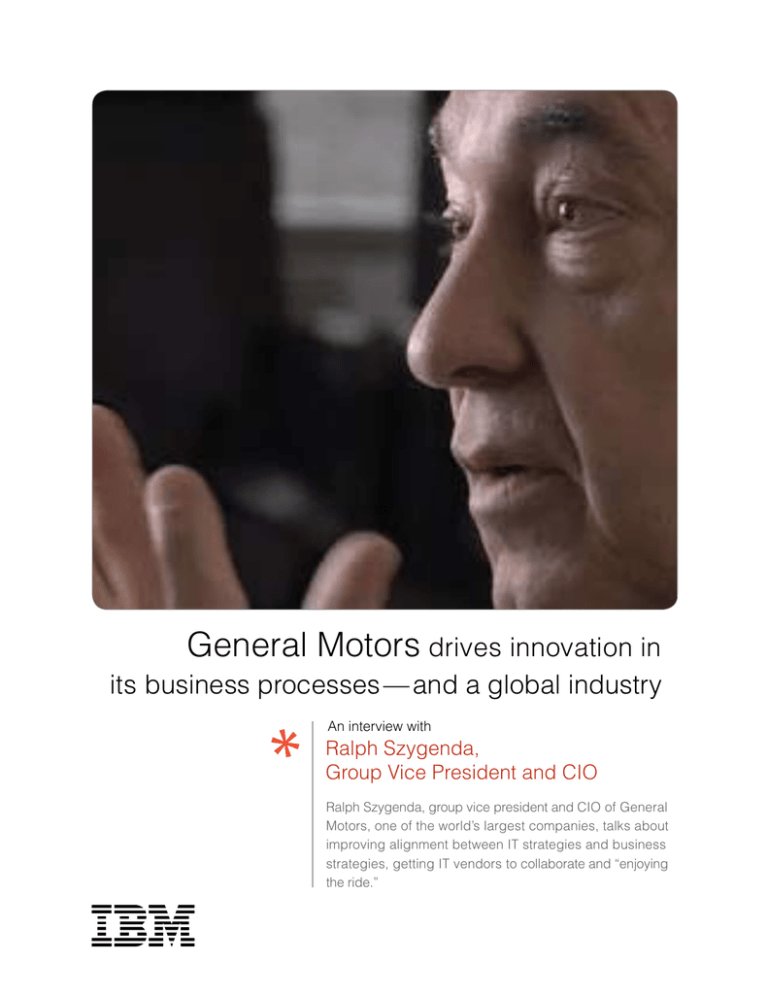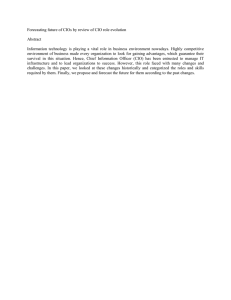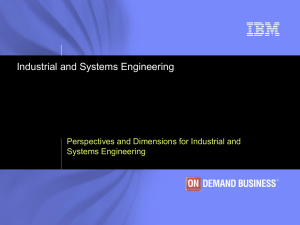
General Motors drives innovation in
its business processes — and a global industry
An interview with
Ralph Szygenda,
Group Vice President and CIO
Ralph Szygenda, group vice president and CIO of General
Motors, one of the world’s largest companies, talks about
improving alignment between IT strategies and business
strategies, getting IT vendors to collaborate and “enjoying
the ride.”
Q. What are the parallels between building
Q. What were the changes that needed to be
an IT organization from scratch and building
a car from scratch?
made when you started?
A. There are many similarities between building
a car and building an IT organization. The engine
of a vehicle, what makes it run, is very similar to
the back-office operations of an IT organization.
But the styling and innovation associated with the
vehicle is what differentiates it in the marketplace.
Those kinds of things really differentiate you as an
IT organization as well.
Q. What’s unique
about working at
General Motors?
A. The product is one of
“The styling and innovation associated
with the vehicle is
what differentiates
it in the marketplace. Those kinds
of things really differentiate you as an IT
organization as well.”
the most complex of any
product produced in the
world. And you quickly
come to the realization that this is like being in the
fashion industry because everyone—friends, family,
neighbors and strangers — has an opinion and critiques your products every day. And the company
itself is complex — it’s big — and it’s global. So it is no
small feat to say we run our business processes the
same throughout the world. We don’t do things differently in the United States versus Europe or Asia.
Q. General Motors’ unique history includes
having its own IT services division that was
EDS and was eventually split off into a separate company. What was that like?
A. In 1996, GM decided that it was best that
EDS be split off. But when it was split off, all of the
company’s IT people went too; therefore, GM was
left without an information technology organization.
Think about this! No IT organization for the world’s
largest corporation. That’s when I was brought in
as the company’s first-ever CIO. When I arrived
the company was decentralized — nothing was
common; all the processes were different. The company had more than 7,000 information systems.
A. When I arrived, I sat down with the chairman
and CEO of the company, who at the time was
Jack Smith, and asked, “Jack, what’s your biggest problem?” He said, “Ralph, it takes too long
to design and develop a car. We’re not competitive anymore. We have to change that. Cycle time
has to be reduced.” And so that was my first major
challenge as the CIO of the company.
Also remember, at the time, I didn’t have an IT organization but had the responsibility to help transform
the company. So beyond changing the product
development process and reducing cycle time, I
was trying to help make manufacturing more efficient and coordinate the delivery of $80 billion of
production material that needed to arrive just in time
in order to build and ship some nine million vehicles
throughout the world.
Q. How did you meet the challenges?
A. I hired a thousand of the best information technology people in the world from outside GM — the
largest influx of executive talent in the history of GM.
Then I took a thousand people from inside GM: the
best automotive process people. I put these groups
together and created the Information Systems &
Services (IS&S) organization. It was a powerful
organization because it combined business people
with information technology people, so everyone
understood what to do from both viewpoints.
I recognized at the time that in order to be the best
automotive company, we had to have the best digital environment that ever existed in the history of any
corporation. And to do that, we’d need this type of
talented team.
Q. With a company as large as GM, how do
you motivate the team?
A. I explained to them that we had the responsibility to improve an icon in global business, to
create the best digital business. Also, by ensuring
they know that their job is first to help the business
succeed. That means building information technology that produces bottom-line, positive business
results. This is what I call Precision IT.
Information technologists love to build information
technology; in a lot of cases, they forget that there
is an end goal. I’ve told my people over the years
that if they build a new information system that has
two million lines of code and they do it on time and
within budget but it doesn’t change the business,
it’s worthless. That’s really disheartening to information technologists, but it really gets the point
across. There is no doubt about it. We are here
for one reason, which is to improve the business.
Q. You created, from scratch, an internal IT
organization, but you’ve also been innovative
by embracing outsourcing of IT. How do you
empower people in that kind of environment?
A. When I arrived at GM in 1996, the IT of GM
had been outsourced already for 12 years. The
outsourcing model was not what I liked and,
I believed, not right for GM. The possibility of
insourcing tens of thousands of people back
into GM did not make sense. We did insource
the thousand people discussed above to architect
and deploy IT, but bringing in those coding and
running computers and operations was not feasible. We had to make outsourcing work.
About two and a half years ago, I asked the CEOs
of the major IT corporations that we work with if they
wanted to help change the IT sourcing business
model. Remember, these are fierce competitors, but
again I asked them if they wanted to assign people
to GM to work together as a team to define a model
for standard IT work processes across their companies. I was clear that we weren’t interested in telling
them in detail how to run their companies, but we
were looking for collaboration that in the end would
help GM but could be used by them in their own
organizations or with any other clients they wanted.
Why did I do this? We’re running a real-time company — a seven-days-a-week, 24-hours-a-day
operation at GM. When a decision needs to be
made, there’s no time to have a meeting to discuss
it. [The IT] companies have to know how to interact
and collaborate with each other instantaneously.
The only way to do that is by using common, wellunderstood IT business processes.
Q. What are the real successes that have
happened at GM in the past ten years?
A. In 1996, we had more than 7,000 information
systems. Today we have fewer than 2,500. That’s
still probably too many, but it’s a significant reduction. We’ve redone the entire telecommunication
environment of the company. We have driven standardization throughout the company worldwide.
And, perhaps most significant, we’ve taken $12 billion
of IT cost out of the company in ten years. Of that
savings, we reinvested $7 billion back into information technology to further transform the company
and gave back $5 billion to the company for use in
other areas of the business.
“In order to be the
best automotive
company, we had
to have the best
digital environment
that ever existed in
the history of any
corporation. And to
do that, we’d need
this type of talented
team.”
Q. You said everything information technologists do must have an impact on the business.
Have you and they succeeded?
A. Without question.
The real impact was in
being able to change
the company. We did.
We’ve standardized our
purchasing processes
throughout the world,
linking to all of our suppliers through an online capability called Supply
Power. We’ve standardized other processes, including sales and marketing, and leverage the same
technology to go to market in about every country in
the world. We’ve created a system called Socrates,
which is a standard internal communication portal
that all of our employees use throughout the world.
Most importantly, in the product development area of our
business, today the cycle time for developing vehicles
has been reduced by more than 50 percent. Where we
once had different computer-aided design systems,
today there is one that is used by 0,000 engineers and
designers and support staff around the world. Ten years
ago they didn’t even talk to each other. Now they work
as one team. It’s quite a different company.
© Copyright IBM Corporation 2007
IBM Global Services
Route 100
Somers, NY 10589
U.S.A.
Produced in the United States of America
07-07
All Rights Reserved
Q. You’ve helped transform GM to a global
IBM and the IBM logo are trademarks or registered
trademarks of International Business Machines
Corporation in the United States, other countries,
or both.
business through innovation and technology.
Has it been worthwhile?
Other company, product and service names may
be trademarks or service marks of others.
A. Sure! GM, as any hundred-year-old company, has
many challenges and areas that must change to be successful. This challenge is what a CIO should relish.
References in this publication to IBM products and
services do not imply that IBM intends to make them
available in all countries in which IBM operates.
The exciting thing about a journey like that occurring at
GM is that you know you have to get to the destination
to be successful, but the fun is in the journey itself. What
happens on the way? Was it enjoyable? Did you make a
difference? Did you overcome obstacles?
The information technology journey is the same. You
have to enjoy the path. You also have to do something
that’s pretty interesting along the way. When you drive
a car, it’s not just about getting from A to B; you want to
enjoy the ride.
It’s always been my philosophy that, if you are trying to
change a business, why not change it to be better than
anybody else?
GTC01487-USEN-00




